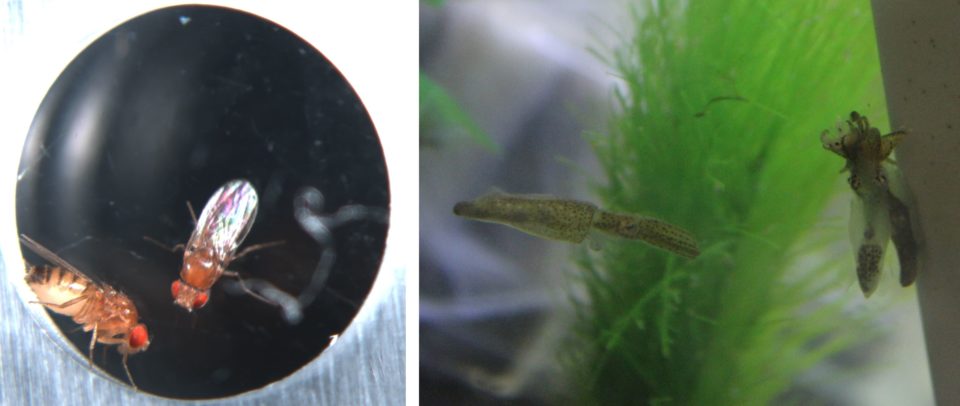TANAKA, NobuakiAssociate Professor
Our primary goal is to reveal how neuronal circuits work as a system to process sensory inputs, and how this processing is modulated by a specific environment or by the mental state or the condition of the body. The answers to these questions would reveal how an animal displays adaptive behavior in response to a given situation that changes moment by moment, or even develops intelligent behavior to cope with a difficult situation. To study these problems in our laboratory, we are utilizing two invertebrate animals, the fly and the cephalopod.
It is not easy to demonstrate the presence of a “mind” in the invertebrates, however, the cephalopods, whose brain-to-body weight ratio exceeds that of most fish and reptiles, show behaviors which would depend on the presence of a so-called “mind.” The comparative analyses of brain functions both between mammals and cephalopods and between cephalopods and insects may lead to a better understanding of what the essence of the “mind” is. Working on such a question may require significant time and effort, but will enrich our lives, don’t you think?
References
- Sugime Y, Watanabe D, Yasuno Y, Shinada T, Miura T, Tanaka NK*. (2017) The upregulation of juvenile hormone titers in female Drosophila melanogaster through mating experiences and host food occupied by eggs and larvae. Zoological Science 34:52-57.
- Yagi R, Mabuchi Y, Mizunami M, Tanaka NK*. (2016) Convergence of multimodal sensory pathways to the mushroom body calyx in Drosophila melanogaster. Scientific Reports 6: 29481; doi: 10.1038/srep29481.
- Koizumi M, Shigeno S, Mizunami M, Tanaka NK*. (2016) Three-dimensional brain atlas of pygmy squid, Idiosepius paradoxus, revealing the largest relative vertical lobe system volume among the cephalopods. Journal of Comparative Neurology 524:2142-2157.
Website
Laboratory of Neurobiology TANAKA Lab
Faculty
Faculty of Science
Department of Biological Sciences
Behavioral Neurobiology
Grad School
Graduate School of Life Science
Division of Life Science
Biosystems Science Course
Contact Information
Faculty of Science, Building #5 5-1012
Email: nktanaka ![[atmark]](https://www2.sci.hokudai.ac.jp/dept/bio/wp/wp-content/themes/sci-bio_2407/img/atmark.png) sci.hokudai.ac.jp
sci.hokudai.ac.jp

